Roasting is a heat process that turns coffee into the fragrant, dark brown beans with which we are most familiar. Before being roasted, the beans were stored green, a state in which they can be kept without loss of quality or taste. Once roasted, however, they should be used as quickly as possible before the fresh roast flavor begins to diminish.
Roasting is a technical skill which approaches an art form. It takes years of training to become an expert roaster with the ability to 'read' the beans and make decisions with split second timing. The difference between perfectly roasted coffee and a ruined batch can be a matter of seconds.
Roasting brings out the aroma and flavor that is locked inside the green coffee beans. A green bean has none of the characteristics of a roasted bean. It is soft and spongy to the bite and smells green, almost 'grassy.' Roasting causes numerous chemical changes to take place as the beans are rapidly brought to very high temperatures. When they reach the peak of perfection, they are quickly cooled to stop the process. Roasted beans smell like coffee, and weigh less because the moisture has been roasted out. They are crunchy to the bite, ready to be ground and brewed.
Most roasters have specialized names for their favored roasts and there is very little industry standardization. This can cause a great deal of confusion for the buyer. But in general, roasts fall into one of four color categories—light, medium, medium-dark or dark. The perfect roast is a subjective choice that is sometimes determined by national preference or geographic location
The Roasts
Within the four color categories, you are likely to find common roasts as listed below. But it is a good idea to ask before you buy. There can be a world of difference between roasts!Light Roasts
Light brown in color. This roast is generally preferred for milder coffee varieties. There will be no oil on the surface of these beans, because they are not roasted long enough for the oils to break through to the surface- Light City
- Half City
- Cinnamon
- New England
Medium Roasts
Medium brown in color with a stronger flavor, and a non-oily surface. This roast is often referred to as the American roast because it is generally preferred in the United States.- City
- American
- Breakfast
Medium—Dark Roasts
Rich, dark color with some oil on the surface and with a slight bittersweet aftertaste- FullCity
Dark Roasts
Shiny black beans with a oily surface and a pronounced bitterness. The darker the roast, the less acidity will be found in the coffee beverage. Dark roast coffees run from slightly dark to charred and the names are often used interchangeably which can be very confusing. Be sure to check your beans before you buy them!- High
- Continental
- New Orleans
- European
- Espresso
- Viennese
- Italian
- French
| 22 °C (72 °F) Green Beans Green coffee beans as they arrive at the dock. They can be stored for up to two years. |
| 165 °C (329 °F) Drying Phase As beans roast, they lose water and increase in size. |
| 196 °C (385 °F) Cinnamon Roast A very light roast level, immediately before first crack. Light brown, toasted grain flavors with sharp acidic tones, almost tea-like in character. |
| 205 °C (401 °F) New England Roast Moderate light brown, but still mottled in appearance. A preferred roast for some specialty roasters, highlights origin characteristics as well as complex acidity. |
| 210 °C (410 °F) American Roast Medium light brown, developed during first crack. Origin character is still preserved. |
| 219 °C (426 °F) City Roast Medium brown, common for most specialty coffee. Good for tasting the varietal character of a bean, although roast character can be noticeable. |
| 240 °C (464 °F) French Roast Dark brown, shiny with oil, burnt undertones, acidity diminished. At the end of second crack. Roast character is dominant at this level. Little, if any, of the inherent flavors of the coffee remain. |
| 245 °C (473 °F) Italian Roast Very dark brown and shiny, burnt tones become more distinct, acidity almost gone, thin body. |
| 250 °C (482 °F) Spanish Roast Extremely dark brown, nearly black and very shiny, charcoal and tar tones dominate, flat, with thin body. |
Caffeine content by roast level
Caffeine content varies by roast level. Caffeine diminishes with increased roasting level: light roast, 1.37%; medium roast, 1.31%; and dark roast, 1.31%.[8] However, this does not remain constant in coffee brewed from different grinds and brewing methods. Because the density of coffee changes as it is roasted, different roast levels will contain respectively different caffeine levels when measured by volume or mass, though the bean will still have the same caffeine.
Roast flavors
At lighter roasts, the bean will exhibit more of its "origin flavor"; the flavors created in the bean by its variety, the soil, altitude, and weather conditions in the location where it was grown.[9]Coffee beans from famous regions like Java, Kenya, Hawaiian Kona, and Jamaican Blue Mountain are usually roasted lightly so their signature characteristics dominate the flavor. As the beans darken to a deep brown, the origin flavors of the bean are eclipsed by the flavors created by the roasting process itself. At darker roasts, the "roast flavor" is so dominant that it can be difficult to distinguish the origin of the beans used in the roast.
Below, roast levels and their respective flavors are described.[10] These are qualitative descriptions, and thus subjective. As a rule of thumb, the "shinier" the bean is, the more dominant the roasting flavors are.
| Roast level | Notes | Surface | Flavor | |
|---|---|---|---|---|
| Light | Cinnamon roast, half city, New England | After several minutes the beans “pop” or "crack" and visibly expand in size. This stage is called first crack. American mass-market roasters typically stop here. | Dry | Lighter-bodied, higher acidity, no obvious roast flavor |
| Medium | Full city, American, regular, breakfast, brown | After a few short minutes the beans reach this roast, which U.S. specialty sellers tend to prefer. | Dry | Sweeter than light roast; more body exhibiting more balance in acid, aroma, and complexity. Smoother than the traditional American "medium" roast, but may display fewer of the distinctive taste characteristics of the original coffee. |
| Full Roast | High, Viennese, Continental | After a few more minutes the beans begin popping again, and oils rise to the surface. This is called second crack. | Slightly shiny | Somewhat spicy; complexity is traded for heavier body/mouth-feel. Aromas and flavors of roast become clearly evident. |
| Double Roast | French | After a few more minutes or so the beans begin to smoke. The bean sugars begin to carbonize. | Very oily | Smokey-sweet; light bodied, but quite intense. None of the inherent flavors of the bean are recognizable. |
Home
roasting
Home roasting is the process of roasting small
batches of green coffee beans for personal consumption. Even after the turn of
the 20th century, it was more common for at-home coffee drinkers to roast their
coffee in their residence than it was to buy pre-roasted coffee. Later, home
roasting faded in popularity with the rise of the commercial coffee roasting
companies. In recent years home roasting of coffee has seen a revival. In some
cases there is an economic advantage, but primarily it is a means to achieve
finer control over the quality and characteristics of the finished product.
Packaging
Extending the shelf life
of roasted coffee relies on maintaining an optimum environment to protect it
from exposure to heat, oxygen, and light. Roasted coffee has an optimal typical
shelf life of 2 weeks, and ground coffee about 15 minutes. Without some sort of
preservation method, coffee becomes stale. The first large scale preservation technique
was vacuum packing in cans. However, because coffee emits CO2 after roasting, coffee
to be vacuum packed must be allowed to de-gas for several days before it is
sealed. To allow more immediate packaging, pressurized canisters or foil-lined
bags with pressure-relief valves can be used. Refrigeration and freezing
retards the staling process. Roasted whole beans can be considered fresh for up
to one month if kept cool. Once coffee is ground it is best used immediately.
Emissions
and control
, and combustion products
are the principal emissions from coffee processing.[13]
Several operations are sources of PM emissions, including the cleaning and
dest
Home
roasting
Home roasting is the process of roasting small
batches of green coffee beans for personal consumption. Even after the turn of
the 20th century, it was more common for at-home coffee drinkers to roast their
coffee in their residence than it was to buy pre-roasted coffee. Later, home
roasting faded in popularity with the rise of the commercial coffee roasting
companies. In recent years home roasting of coffee has seen a revival. In some
cases there is an economic advantage, but primarily it is a means to achieve
finer control over the quality and characteristics of the finished product.
Packaging
Extending the shelf life
of roasted coffee relies on maintaining an optimum environment to protect it
from exposure to heat, oxygen, and light. Roasted coffee has an optimal typical
shelf life of 2 weeks, and ground coffee about 15 minutes. Without some sort of
preservation method, coffee becomes stale. The first large scale preservation technique
was vacuum packing in cans. However, because coffee emits CO2 after roasting, coffee
to be vacuum packed must be allowed to de-gas for several days before it is
sealed. To allow more immediate packaging, pressurized canisters or foil-lined
bags with pressure-relief valves can be used. Refrigeration and freezing
retards the staling process. Roasted whole beans can be considered fresh for up
to one month if kept cool. Once coffee is ground it is best used immediately.
Emissions
and control
Particulate matter (PM), volatile organic compounds (VOC),
organic acids, and combustion products
are the principal emissions from coffee processing.[13]
Several operations are sources of PM emissions, including the cleaning and
destoning equipment, roaster, cooler, and instant coffee drying equipment. The
roaster is the main source of gaseous pollutants,
including alcohols, aldehydes, organic acids, and nitrogen and sulfur
compounds. Because roasters are typically natural gas-fired, carbon monoxide (CO) and carbon dioxide (CO2)
emissions result from fuel combustion. Decaffeination and instant coffee extraction and drying
operations may also be sources of small amounts of VOC. Emissions from the
grinding and packaging operations typically are not vented to the atmosphere.
Particulate matter
emissions from the roasting and cooling operations are typically ducted to cyclones before
being emitted to the atmosphere. Gaseous emissions from roasting operations are
typically ducted to a thermal oxidiser or thermal catalytic oxidiser following
PM removal by a cyclone. Some facilities use the burners that heat the roaster
as thermal oxidisers. However, separate thermal oxidisers are more efficient
because the desired operating temperature is typically
between 650–816 °C (1,202–1,501 °F), which is 93–260 °C
(199–500 °F) more than the maximum temperature of most roasters. Some
facilities use thermal catalytic oxidizers, which require lower operating
temperatures to achieve control efficiencies that are equivalent to standard
thermal oxidizers. Catalysts are also used to improve
the control efficiency of systems in which the roaster exhaust is ducted to the
burners that heat the roaster. Emissions from spray dryers are
typically controlled by a cyclone followed by a wet scrubber.
oning equipment, roaster, cooler, and instant coffee drying equipment. The
roaster is the main source of gaseous
pollutants,
including alcohols, aldehydes, organic acids, and nitrogen and sulfur
compounds. Because roasters are typically natural gas-fired, carbon monoxide (CO) and carbon dioxide (CO2)
emissions result from fuel combustion. Decaffeination and instant coffee extraction and drying
operations may also be sources of small amounts of VOC. Emissions from the
grinding and packaging operations typically are not vented to the atmosphere.
Particulate matter
emissions from the roasting and cooling operations are typically ducted to cyclones before
being emitted to the atmosphere. Gaseous emissions from roasting operations are
typically ducted to a thermal oxidizer or thermal catalytic oxidizer following
PM removal by a cyclone. Some facilities use the burners that heat the roaster
as thermal oxidizers. However, separate thermal oxidizers are more efficient
because the desired operating temperature is typically
between 650–816 °C (1,202–1,501 °F), which is 93–260 °C
(199–500 °F) more than the maximum temperature of most roasters. Some
facilities use thermal catalytic oxidizers, which require lower operating
temperatures to achieve control efficiencies that are equivalent to standard
thermal oxidizers. Catalysts are also used to improve
the control efficiency of systems in which the roaster exhaust is ducted to the
burners that heat the roaster. Emissions from spray dryers are
typically controlled by a cyclone followed by a wet scrubber.
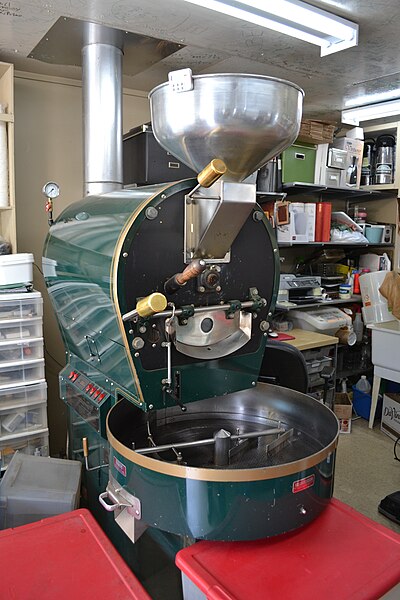
Diedrich IR Series Coffee Roaster.
| ||||
A two barrel coffee roaster for roasting coffee samples prior to purchasing or
roasting green coffee beans.
| ||||
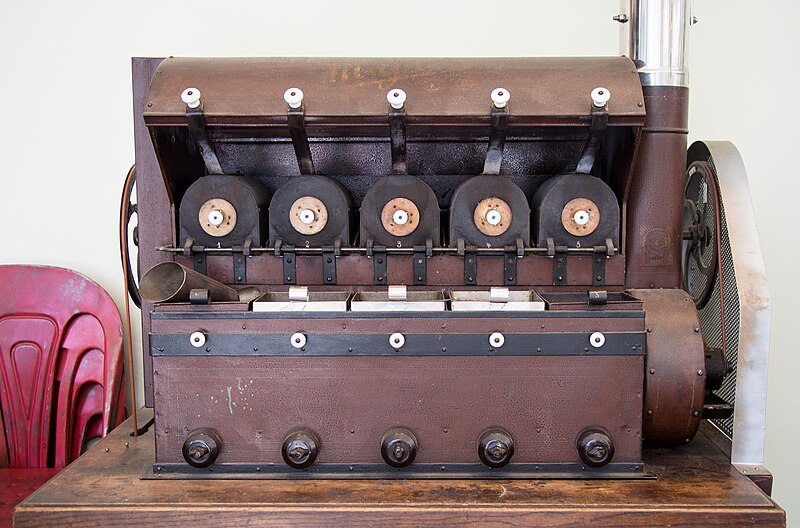
An antique "Mignon" five barrel test roasting machine
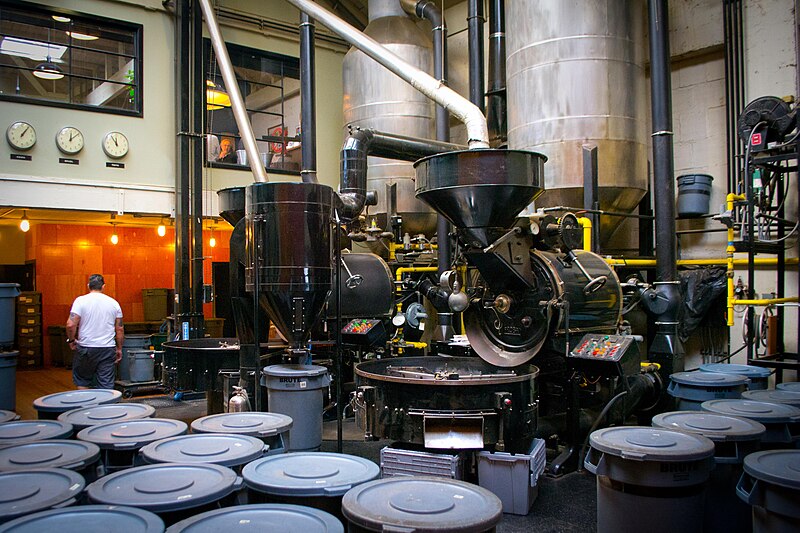
The roasting room at a midsize coffee company.

An old wood-fired coffee roaster
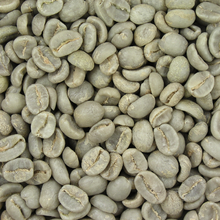

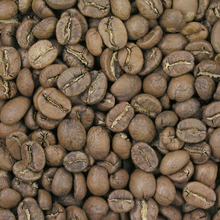


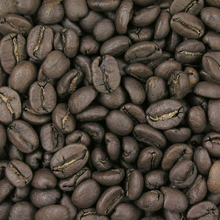

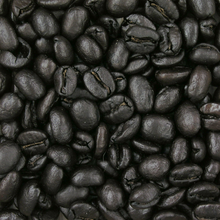

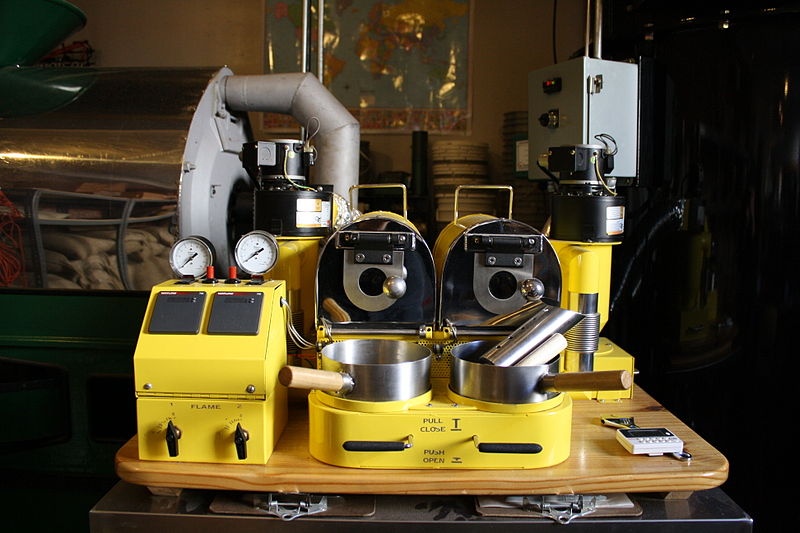
1 comment:
This article is pretty interesting. I think most of the people like to roast their coffee at 219 °C which gives perfect taste to coffee. There are so many ways to roast the coffee and different people employ different process. Thank you for sharing this awesome informative post.
Regards,
Finn Felton
Kopi Luwak
Post a Comment